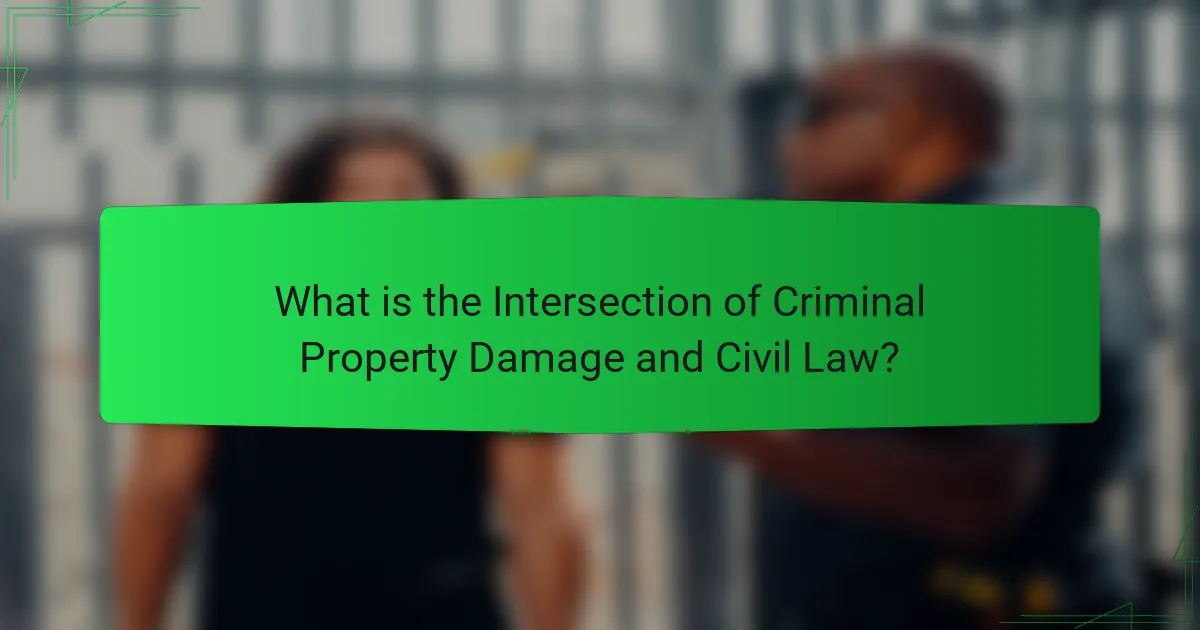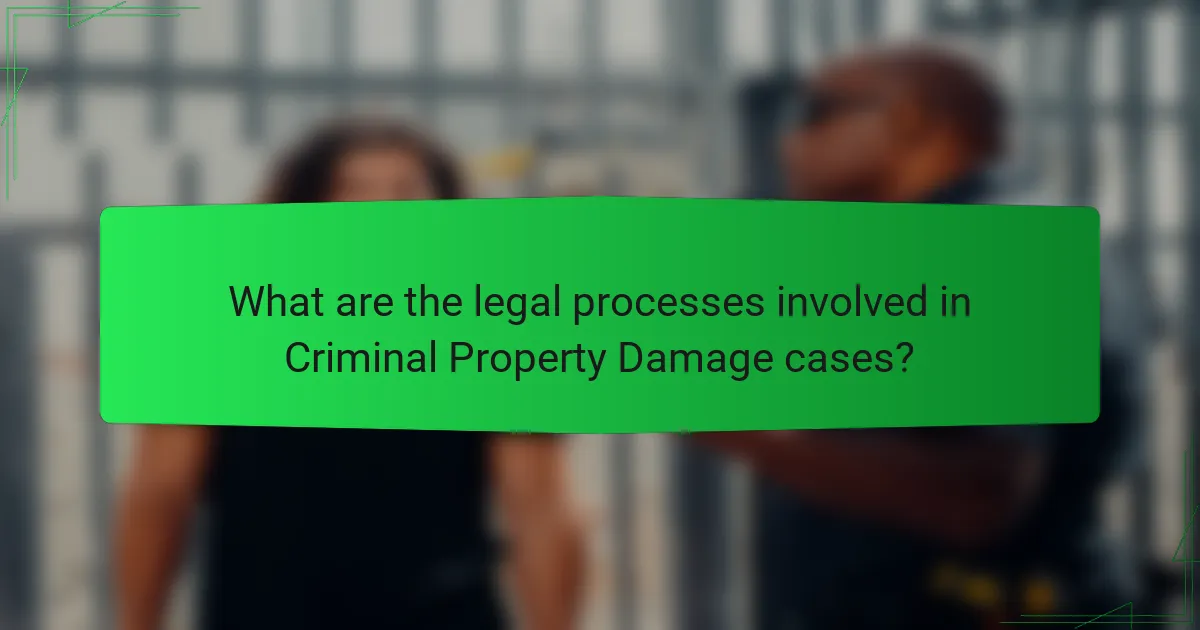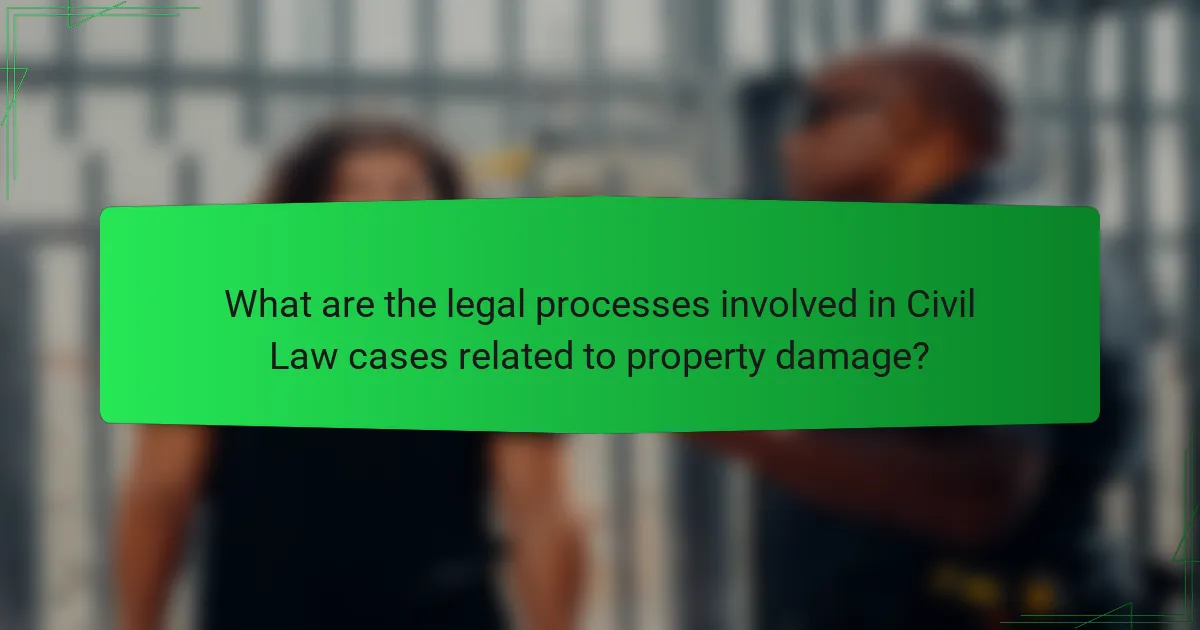The article examines the intersection of criminal property damage and civil law, highlighting the key differences between these two legal frameworks. Criminal property damage refers to offenses that result in state prosecution, while civil law addresses individual disputes regarding property damage and compensation. The article outlines the legal processes involved in both criminal and civil cases, detailing steps such as investigation, arraignment, and trial in criminal cases, and complaint filing, discovery, and verdict delivery in civil cases. It emphasizes the distinct outcomes in each realm, with criminal cases focusing on punishment and civil cases prioritizing restitution for the aggrieved party.

What is the Intersection of Criminal Property Damage and Civil Law?
The intersection of criminal property damage and civil law occurs when actions causing harm to property violate both criminal statutes and civil regulations. Criminal property damage involves offenses that may lead to prosecution by the state. Civil law addresses disputes between individuals regarding property damage and compensation. For instance, a vandalized property can result in criminal charges against the offender and a civil lawsuit from the property owner seeking damages. The outcomes in both realms can differ; criminal cases focus on punishment, while civil cases prioritize restitution. This dual framework emphasizes accountability in both legal systems.
How do Criminal Property Damage and Civil Law differ fundamentally?
Criminal property damage and civil law differ fundamentally in their purpose and consequences. Criminal property damage involves actions that violate laws designed to protect public order and safety. Such actions can lead to prosecution by the state and potential imprisonment. Civil law, on the other hand, addresses disputes between individuals or entities regarding rights and obligations. It typically results in monetary compensation or specific performance rather than criminal penalties.
In criminal cases, the burden of proof is on the prosecution, requiring evidence beyond a reasonable doubt. In civil cases, the standard is lower, requiring a preponderance of evidence. Criminal property damage may also involve restitution to victims, while civil law focuses on compensatory damages. The outcomes in criminal cases can include fines, community service, or incarceration, whereas civil law outcomes usually involve financial settlements.
What defines Criminal Property Damage in legal terms?
Criminal Property Damage is defined as the intentional destruction or alteration of another person’s property. This legal term encompasses actions that cause physical harm or loss to property. Examples include vandalism, arson, or graffiti. The intent to damage or destroy is a critical element in establishing this offense. Laws vary by jurisdiction but generally classify it as a criminal act. Penalties can include fines, restitution, or imprisonment. In some cases, the severity of the damage determines the level of the offense. For instance, significant damage may lead to felony charges, while minor damage may result in misdemeanors.
What are the key characteristics of Civil Law as it relates to property damage?
Civil Law regarding property damage primarily focuses on compensation for losses incurred. It establishes liability based on negligence or intentional harm. The burden of proof lies with the plaintiff, who must demonstrate the defendant’s responsibility. Civil Law allows for claims based on actual damages, including repair costs and loss of value. Punitive damages may also be awarded in cases of egregious conduct. Statutes of limitations dictate the timeframe for filing claims, typically ranging from one to six years, depending on jurisdiction. Legal precedents guide interpretations and applications of Civil Law in property damage cases.
Why is understanding these differences important?
Understanding the differences between criminal property damage and civil law is crucial for effective legal navigation. Each area of law has distinct procedures, consequences, and standards of proof. Criminal law typically involves state prosecution, while civil law is usually initiated by private parties. The burden of proof in criminal cases is “beyond a reasonable doubt,” whereas in civil cases it is “preponderance of the evidence.” Misunderstanding these differences can lead to incorrect legal strategies and outcomes. For instance, a party may pursue a civil claim when criminal charges are more appropriate, or vice versa. This misalignment can affect compensation, penalties, and overall justice. Accurate comprehension ensures proper legal representation and informed decision-making.
How do the consequences differ between Criminal and Civil cases?
Criminal cases typically result in punishment, such as imprisonment or fines. In contrast, civil cases generally lead to monetary compensation or specific performance. Criminal cases involve the state prosecuting an individual for violating laws. Civil cases involve disputes between private parties seeking remedies for wrongs. The burden of proof in criminal cases is “beyond a reasonable doubt.” In civil cases, the standard is “preponderance of the evidence.” Criminal convictions can lead to a criminal record, affecting future opportunities. Civil judgments primarily impact financial liability and do not result in criminal records.
What impact does the legal framework have on victims and offenders?
The legal framework significantly impacts both victims and offenders. It establishes the rights of victims to seek justice and restitution. Victims are often granted the opportunity to present their case in court. This can lead to compensation for damages incurred. Offenders, on the other hand, are subject to penalties defined by law. These penalties can include fines, imprisonment, or community service. The legal framework also influences the rehabilitation opportunities available to offenders. Laws may dictate the conditions under which offenders can reintegrate into society. Overall, the legal framework shapes the experiences and outcomes for both victims and offenders in the justice system.

What are the legal processes involved in Criminal Property Damage cases?
Criminal property damage cases involve several legal processes. First, law enforcement investigates the incident. They collect evidence and interview witnesses. Next, the prosecutor reviews the evidence. They determine if there is enough to file charges. If charges are filed, the defendant is arraigned in court. During arraignment, the defendant enters a plea. A trial may follow if the case is not resolved through a plea deal. The trial involves presenting evidence and witness testimonies. After the trial, a verdict is delivered. If found guilty, sentencing occurs, which may include fines or restitution. These processes ensure that justice is served in cases of property damage.
How does the prosecution work in Criminal Property Damage cases?
The prosecution in criminal property damage cases involves several key steps. First, law enforcement investigates the incident. This includes gathering evidence, interviewing witnesses, and documenting the damage. Next, the prosecutor reviews the evidence to determine if charges are warranted. The prosecution must establish that the defendant intentionally or recklessly caused property damage.
If charges are filed, the case proceeds to court. The prosecution presents evidence to support its case. This may include photographs of the damage, expert testimony, and witness statements. The defendant has the right to present a defense and challenge the prosecution’s evidence.
The burden of proof lies with the prosecution. They must prove the defendant’s guilt beyond a reasonable doubt. Successful prosecution can result in penalties such as fines, restitution, or imprisonment. Each jurisdiction may have specific laws governing criminal property damage, affecting how prosecutions are conducted.
What evidence is required to prove Criminal Property Damage?
To prove Criminal Property Damage, evidence must demonstrate intentional or reckless destruction of property. This includes photographs of the damage, witness statements, and police reports. Documentation of repair costs can also support the claim. Surveillance footage may provide visual proof of the act. Additionally, the presence of physical evidence, such as tools used for damage, strengthens the case. Testimonies from the property owner about the impact of the damage are also relevant. Collectively, this evidence establishes the elements required for a conviction in criminal property damage cases.
What are the potential penalties for offenders in Criminal Property Damage cases?
Potential penalties for offenders in Criminal Property Damage cases can include fines, restitution, and imprisonment. Fines can vary widely based on the extent of the damage. Restitution may require the offender to compensate the victim for repair costs. Imprisonment can range from a few days to several years, depending on the severity of the offense. In many jurisdictions, repeat offenders may face harsher penalties. For example, felony charges can lead to more significant prison time and higher fines. The specific penalties are often outlined in local laws, reflecting the seriousness of the crime.
What role do victims play in Criminal Property Damage cases?
Victims play a crucial role in Criminal Property Damage cases. They provide evidence of the damage incurred. Victims often report the incident to law enforcement. Their testimony can help establish the facts of the case. Victims may also identify suspects involved in the damage. Their involvement can influence the prosecution’s approach. Additionally, victims may seek restitution for damages. This financial aspect can be a significant factor in the case outcome.
How can victims seek restitution in Criminal cases?
Victims can seek restitution in criminal cases through the court system. They must typically file a request for restitution during the criminal proceedings. The court will evaluate the request based on the evidence presented. This may include documentation of losses incurred due to the crime. The judge has the discretion to grant or deny the request. If granted, restitution orders require the offender to compensate the victim for their losses. Victims should work closely with prosecutors to ensure their rights are protected. Successful restitution claims can provide financial relief to victims affected by crime.
What rights do victims have during the legal process?
Victims have specific rights during the legal process. These rights may include the right to be informed about the progress of the case. Victims often have the right to participate in court proceedings. They can provide impact statements during sentencing. Victims may also have the right to legal representation. Additionally, they can request restitution for damages incurred. Many jurisdictions ensure victims are treated with dignity and respect. Statutes like the Crime Victims’ Rights Act in the U.S. support these rights. These protections aim to empower victims throughout the legal process.

What are the legal processes involved in Civil Law cases related to property damage?
The legal processes involved in Civil Law cases related to property damage include several key steps. First, the aggrieved party files a complaint in a civil court. This initiates the legal proceedings. Next, the defendant is served with the complaint and given a chance to respond. The defendant’s response may include an admission or denial of the allegations.
Following this, both parties engage in the discovery process. This involves exchanging evidence and information relevant to the case. After discovery, the case may proceed to pre-trial motions. These motions can resolve specific legal issues before trial.
If the case is not settled, it will go to trial. During the trial, both sides present their arguments and evidence. After deliberation, the judge or jury delivers a verdict. If the plaintiff wins, damages may be awarded to compensate for the property damage.
These processes ensure that disputes are resolved fairly under Civil Law principles.
How does filing a civil lawsuit for property damage work?
Filing a civil lawsuit for property damage involves several key steps. First, the plaintiff must gather evidence of the damage. This includes photographs, repair estimates, and witness statements. Next, the plaintiff files a complaint in the appropriate court. The complaint outlines the facts of the case and the damages sought. After filing, the defendant is served with the complaint and has a set time to respond. If the defendant does not respond, the plaintiff may win by default. The case may proceed to discovery, where both parties exchange information. Finally, the case may go to trial, where a judge or jury decides the outcome. According to the American Bar Association, understanding these steps is crucial for successful litigation.
What are the steps involved in initiating a Civil Law case?
The steps involved in initiating a Civil Law case include filing a complaint, serving the defendant, and conducting discovery. The plaintiff must first draft and file a complaint in the appropriate court. This document outlines the claims against the defendant. Next, the plaintiff must serve the defendant with the complaint and a summons to appear in court. This ensures the defendant is aware of the legal action. After service, both parties engage in discovery, which involves exchanging evidence and information. This phase may include depositions, interrogatories, and requests for documents. Once discovery is complete, the case may proceed to trial or settlement discussions. Each step is crucial for establishing the legal framework and ensuring due process.
What types of damages can be claimed in a Civil Law case?
In a Civil Law case, several types of damages can be claimed. These include compensatory damages, which are intended to reimburse the injured party for actual losses. Compensatory damages can be further divided into economic and non-economic damages. Economic damages cover quantifiable losses, such as medical expenses and lost wages. Non-economic damages address intangible losses, like pain and suffering.
Additionally, punitive damages may be awarded to punish the wrongdoer and deter future misconduct. These damages are not related to the actual loss but are meant to serve as a punishment. In some cases, nominal damages may be awarded to acknowledge a legal wrong without substantial loss.
These categories of damages are recognized in various legal systems and provide a framework for compensation in civil disputes.
How do case outcomes differ between Criminal and Civil Law?
Criminal law outcomes typically involve punishment, while civil law outcomes focus on compensation. In criminal cases, the state prosecutes individuals for offenses against society. Convictions can result in jail time, fines, or community service. In civil law, individuals or entities sue for damages or enforcement of rights. Outcomes usually involve monetary compensation or specific performance. Criminal cases require proof beyond a reasonable doubt. Civil cases only require a preponderance of evidence. This distinction leads to differing case resolutions and consequences for defendants.
What factors influence the outcomes of Criminal Property Damage cases?
The outcomes of Criminal Property Damage cases are influenced by several key factors. Evidence quality plays a crucial role; strong, clear evidence can lead to more favorable outcomes. The severity of the damage also impacts the case; significant damage may result in harsher penalties. The intent of the perpetrator is considered; intentional acts are treated more seriously than accidental damage. Jurisdictional laws vary; different regions have unique statutes that affect case outcomes. Prior criminal history of the defendant can influence sentencing; repeat offenders may face stricter penalties. Victim statements and testimonies are influential; their perspectives can sway judicial decisions. Legal representation quality is critical; experienced attorneys can improve case outcomes significantly. Lastly, public sentiment and media coverage may affect the case; high-profile cases can lead to heightened scrutiny and pressure on the judicial process.
What factors influence the outcomes of Civil Law cases related to property damage?
The outcomes of Civil Law cases related to property damage are influenced by several key factors. These factors include the extent of damage, applicable laws, and the burden of proof. The severity of the damage directly impacts compensation amounts. Relevant laws dictate liability and restitution procedures. The burden of proof lies with the plaintiff, requiring evidence to support claims. Witness testimonies and expert opinions can significantly sway case results. Additionally, prior case precedents can guide judicial decisions. Jurisdictional differences may also affect how laws are interpreted and enforced. Finally, the credibility of the parties involved plays a crucial role in case outcomes.
What practical steps can be taken when dealing with property damage cases?
Document the damage thoroughly. Take clear photographs of all affected areas. Create a detailed list of damaged items with estimated values. Report the incident to your insurance company promptly. Provide them with all documentation and evidence collected. File a police report if necessary, especially for vandalism or theft. Keep records of all communications with insurance and law enforcement. Consult with a legal professional if disputes arise regarding liability or compensation. These steps ensure a comprehensive approach to managing property damage cases.
How can individuals protect their rights in both Criminal and Civil contexts?
Individuals can protect their rights in both criminal and civil contexts by understanding legal processes and seeking professional legal advice. In criminal cases, individuals should be aware of their right to remain silent and the right to an attorney. These rights are protected under the Fifth and Sixth Amendments of the U.S. Constitution. In civil cases, individuals can file lawsuits to seek damages or injunctions. They should gather evidence and document incidents relevant to their claims. Consulting with an attorney can provide guidance on navigating both systems effectively. Legal representation ensures that individuals’ rights are upheld throughout the proceedings.
What resources are available for victims of property damage?
Victims of property damage can access various resources for assistance. Local government agencies often provide support programs for affected individuals. Non-profit organizations may offer financial aid and counseling services. Insurance companies typically assist with claims related to property damage. Legal aid organizations can provide free or low-cost legal advice. Community support groups may help victims connect with others facing similar challenges. Online resources and hotlines can offer guidance and information on next steps. These resources collectively aim to help victims recover and rebuild after property damage incidents.
The main entity of this article is the intersection of criminal property damage and civil law, which explores how actions causing harm to property can violate both criminal statutes and civil regulations. The article outlines the fundamental differences between criminal property damage, which focuses on state prosecution and punishment, and civil law, which addresses disputes between individuals and seeks monetary compensation. Key topics include the legal definitions, processes involved in both criminal and civil cases, the burden of proof, potential penalties, and the rights of victims. Understanding these differences is essential for navigating the legal landscape effectively and ensuring proper representation in property damage cases.